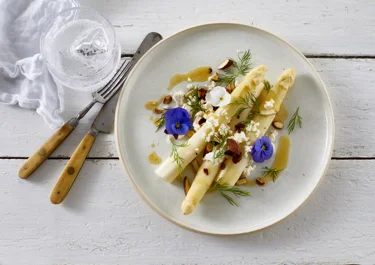White asparagus

White asparagus is among the most delicious spring and summer treats. Their season is quite short, so make the best of it with our recipe for white asparagus with browned butter. This combination takes the fresh vegetable to a higher level, creating a brilliant wow effect for your family and friends! Garnish with fresh, bright green dill and colourful edible flowers, and you have the perfect light lunch or side dish for a lovely spring or midsummer dinner.
Ingredients
Browned Butter
Asparagus
|
½ l
Water
|
|
|---|---|
|
½ tsp
Coarse salt
|
|
|
300 g
White asparagus, peeled whole
|
Garnish
|
100 g
Salad cheese in cubes
|
|
|---|---|
|
50 g
Almonds, coarsely chopped, toasted, and skinned
|
|
|
100 ml
Dill sprigs
|
|
|
100 ml
Edible flowers, for example, blue pansies
|
Instructions
Browned Butter
Asparagus
For Serving
Recipe tips
It’s often the small details that make the biggest impact in the kitchen, so we’re sharing the tips we rely on when cooking and creating recipes
You can prepare the browned butter well in advance and quickly reheat it before serving. If you are making a big batch of browned butter, the cooking times will vary. Look closely as it starts to brown and smell it occasionally to detect nutty notes, determining when the browned butter is ready.
When choosing your asparagus, try to choose some that are uniform in size and thickness. This ensures they cook evenly, so every piece is perfectly tender. After boiling and draining them, gently pat them dry with a kitchen towel. This helps remove any excess moisture, ensuring that the browned butter clings to the asparagus better, so you get even more of that delicious flavour.
FAQ: Questions about white asparagus
Do you want to learn more about this fresh delicacy? Then keep reading our questions about white asparagus below!
What is white asparagus?
White asparagus is a variety of asparagus grown underground or covered, meaning it is not exposed to sunlight, which prevents it from becoming green. It is loved for its delicate flavour and tender texture. This seasonal delicacy has a rather short season, typically from April to June. White asparagus has a taste that is slightly milder and more refined than its green counterpart.
How to peel white asparagus?
It is important to peel white asparagus because of its tough, fibrous outer layer. Wash the asparagus under cold water and snap off the woody end at the base of each stalk; it should break naturally at the right point. Using a vegetable peeler, gently peel away the outer skin, starting from just below the tip down to the end where it was snapped. Be careful not to peel the very tip, as it is tender. Rinse the peeled asparagus again before cooking.
How long to boil white asparagus?
White asparagus typically takes longer to cook than green asparagus because of its thicker and more fibrous stalks. Bring a large pot of salted water to a boil and add the peeled and washed asparagus. Boil for about 4–6 minutes for thin stalks and 8–12 minutes for thick talks. The asparagus should be tender when pierced with a knife but still firm.
Can you freeze white asparagus?
Yes, you can freeze white asparagus, but it is best to blanch it first to preserve its texture and flavour. Clean and peel the asparagus and blanch in boiling water for 2–4 minutes, depending on the thickness. Cool it quickly in ice water to stop the cooking process. Drain well and freeze in airtight bags or containers. You can freeze it for 8–12 months, and it will still maintain its best quality. After freezing, prepare and cook the asparagus directly from its frozen state without thawing it first, which helps to preserve its texture. Roast, steam, boil, sauté, or grill it; just make sure to cook it at a higher heat to help remove any excess moisture and improve the texture.
Do you have to peel white asparagus?
Yes, you do have to peel white asparagus if you want the right texture and flavour. The outer layer is tough and fibrous in varying degrees depending on the asparagus’ maturity and thickness, and this layer makes it unpleasant to eat if you do not remove it.
Is white asparagus the same as green?
While white and green asparagus are the same plant, they vary in colour and slightly in taste because of the growing process. Green asparagus grows exposed to sunlight, which gives it its green colour and a slightly grassier flavour. White asparagus, grown underground or covered, remains white and has a more delicate, less bitter flavour. Despite these differences, they can often be used interchangeably in recipes, but you have to consider their varying cooking times due to the white variety’s thicker stalks.
White asparagus with browned butter – a perfect summer treat
For a few months in late spring and early summer, we get to enjoy the exquisite white asparagus. Make the best of the season with our summery recipe, where you get to enjoy its deliciously tender, almost buttery texture and delicate, nuanced, and mild flavour. The browned butter drizzled on top adds a rich, nutty aroma that beautifully complements the asparagus’ sweetness. This simple yet elegant dish captures the essence of the beginning of summer with its fresh, seasonal ingredients and vibrant colours from fresh dill and edible flowers. Whether you enjoy it as a light lunch or as part of a festive summer dinner menu, our recipe is sure to delight your taste buds and impress family and guests.
You can serve your white asparagus as a side dish to other summer dishes, for example, serving it with other sides such as boiled new potatoes or a delicious burrata salad.
Serve with crumbled salad cheese and crunchy almonds
To complement the delicate white asparagus and browned butter, we add salty salad cheese and toasted almonds. The cheese brings a tangy contrast that elevates the asparagus’ subtle sweetness, and toasted almonds introduce a delightful crunch, adding a sumptuous depth with their earthy flavour. Serving it with these toppings enhances the freshness of the asparagus, and you get to enjoy a beautifully rounded dish you will want to make again and again during the asparagus season.
White asparagus vs green asparagus
Green and white asparagus vary in both texture and flavour, even though they come from the same plant. White asparagus grows shielded from sunlight, preventing it from turning green like green asparagus, which grows above ground. The lack of sunlight for white asparagus results in a milder, somewhat sweeter flavour compared to its green counterpart, which has a more pronounced, slightly grassy taste.
In terms of texture, white asparagus is thicker and requires peeling to remove its fibrous outer layer, leading to a softer, more delicate texture when cooked. Green asparagus tends to be more tender from the start and can often be cooked and eaten without peeling, offering a bit of a crunch. Whether you prefer the gentle taste of white asparagus or the vibrant, earthy flavour of green, both bring distinct qualities in taste and texture to the table that goes well with a wide range of dishes.
Ideas for varying the recipe
Our recipe is so easy to experiment with while still keeping the main elements of the asparagus and browned butter. Add a citrus twist, drizzling lemon juice over the asparagus just before serving, or garnish with lemon zest. The citrus adds a fresh, bright flavour that complements the richness of the browned butter. You can also add garlic cloves for a mellow, sweet garlic flavour. Roast garlic in the oven, mash it into a paste, and then mix it into the browned butter before drizzling over the white asparagus.
For a smoky flavour, grill the asparagus instead of boiling it. Brush them lightly with olive oil, season with salt and pepper, and grill until tender. Serve with the browned butter as usual. If you choose this version, you can also wrap the asparagus stalks in thin slices of prosciutto before cooking − the saltiness of the ham contrasts nicely with the mildness of the asparagus and the richness of the butter.









